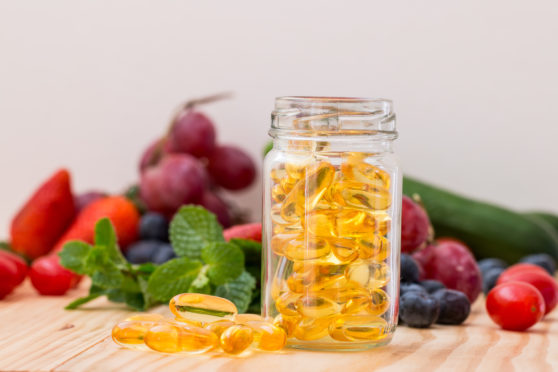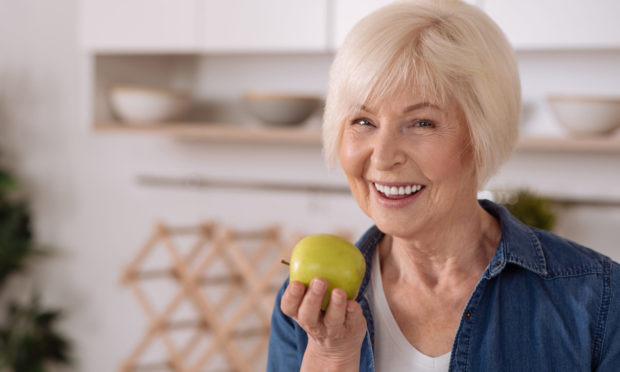With high-profile new studies throwing a spotlight on how diet affects the ageing process, Dr Carrie Ruxton summarises the evidence and reveals what we can do to give ourselves the best quality of life in our later years.
It seems barely a day goes by without a new study on how different foods and nutrients affect our health.
So much science can be bewildering – not least because the results can be contradictory. Most recently a huge study overseen by researchers at University College London (UCL) looked at the health of 135,000 people and found that although life expectancy is increasing, our quality of life in our later years is decreasing – a fact which was attributed to lifestyle.
With diet now coming into sharp focus amid fears of a second wave of the coronavirus, health officials, campaigners and politicians are asking Britons who are overweight to make changes to their diet in order to improve their own chances of survival and reduce pressure on the NHS. Age is also a factor, with those over 50 most at risk.
The UCL study suggests that people now in their 40s and 50s are in worse shape than those from previous generations. And although they are expected to live longer, their quality of life may well be poorer due to bad health with conditions including obesity, high blood pressure, diabetes, hypertension and circulatory problems – many of which are interlinked. Poor diet and a lack of exercise are cited as crucial factors.
To add to the mix, a review published in the American Heart Association journal Hypertension, has found that a chemical in our bloodstream known as TMAO is thought to be produced at particularly high levels when we eat red meat. Our gut bacteria breaks down meat proteins which are then converted into TMAO. The bad news is that those with higher levels of TMAO in their blood have a greater risk of heart attack or stroke, causing some to speculate that eating red meat could speed up age-related health problems.
With so much conflicting science and information circulating around red meat, it makes it difficult to work out what on earth we should be putting on our plates each day. But, says Dr Carrie Ruxton, a Cupar-based dietitian with the Health and Food Supplements Information Service, it’s not red meat in itself that is the issue, it’s the type and amount of meat.
She said: “The TMAO evidence is still too contradictory to apply to human diets as it mainly comes from studies on mice. TMAO is produced in our bodies from L-carnitine which is found in dairy, fish and poultry as well as red meat. However, a recent US study found that older women who ate a high animal-protein diet didn’t produce any extra TMAO.
“We do need to be conscious of our gut health, and our ‘friendly’ bacteria are crying out for plant fibre. But when it comes to red meat I think there is a role for moderate intakes in the diet. A lot of the studies are observational which doesn’t give the full picture as high meat consumers are typically middle aged men, who are overweight and drink too much, and eat processed, fattier meats rather than wholesome, lean meats.”
Food Standards Scotland recommends adults eat no more than 70g a day of red and processed meat. Dr Ruxton says the quality and fat content of the meat is also important.
She added: “It’s not necessary to give up meat. People need protein and iron as they get older and red meat is a great source. Think instead about choosing unprocessed lean meats and adding plenty of veggies, instead of having pies and bridies with chips.”
And when it comes to slowing the ageing process, Dr Ruxton is in no doubt of the role diet plays.
She said: “The most frightening statistic is that around 20% of our life is spent in ill health. We are living longer but we’re not any healthier. For many of us, the extra years are spent in ill-health so we’re not benefiting from them. But if you start making changes in your 40s and 50s and maybe even 60s there is good evidence that certain nutrients can help slow the ageing process.”
With studies showing we can lack essential nutrients in our later years, diet and supplements play an ever-increasing role.
Dr Ruxton on the nutrients that can boost life quality in our later years
Omega 3 fatty acids
“The evidence is really good for omega-3 fatty acids and that’s because they’re very important for brain function and health. In our brains, omega-3 fats support the structure of our blood vessels and the little junctions in the nerves where messages jump across, called synapses. Omega 3s, like DHA and EPA, make the membranes around our brain cells very fluid, so the transfer of nutrients and oxygen is more efficient. Studies show that people who have oily fish and marine oils in their diets have a lower risk of dementia and cognitive decline. You can get omega 3s from oily fish (salmon, mackerel, tuna) or from supplements such as cod liver oil and algae-based vegan alternatives. Omega 3s are also linked with less inflammation in joints and a reduced risk of heart attack. Aim to eat fish twice a week or consider a supplement.”
Protein and vitamin D
“A lot of older people fall because they lose muscle function which is supported through a combination of protein and vitamin D. There is an authorised health claim at European level for vitamin D preventing falls in older people, so the evidence is strong. Spread out your protein foods across the day for maximum impact on muscle function, and choose high-quality proteins from eggs, fish, lean meat and soya.”
Plant-based fibre
“With gut bacteria the only thing we know for certain with ageing is that as you get older you have less diversity in your gut. Less diversity leads to gut permeability, or leaky gut, which can cause inflammation. So we want to eat foods that keep our gut bacteria happy and keep inflammation down. The best way of doing that is by eating plenty of plant-based fibre sourced from fruits and vegetables, pulses, nuts, seeds and wholegrains.”
B vitamins
“There are several types of B vitamin which are found in protein foods like meat, fish, eggs, poultry, nuts and seeds.
They have different functions in the body, including supporting the skin, eyes and nervous system and helping to form red blood cells.
You would think we should be able to get enough vitamin B through diet, but as we get older it becomes harder to absorb vitamin B12 in particular. Deficiency can lead to anaemia and neurological problems. Taking a daily B vitamin complex or a multivitamin has been shown to support cognitive health in older people.”
Calcium and vitamin D
“For bone health, calcium and vitamin D work together to build and preserve the structure of bones. Osteoporosis is a massive problem in both women and men and is linked to low intakes of these nutrients. Studies show that a combined calcium and vitamin D supplement is helpful for bone health in people over 50, especially woman going through menopause. Regular exercise, especially using weights or resistance bands, also prevents bone loss. During this pandemic, the government recommends that everyone considers a daily 10 microgram vitamin D supplement since so many people have low blood levels.”
Further reading..
Feeling flat? Why nutritional deficiencies could be behind some of our common ailments


